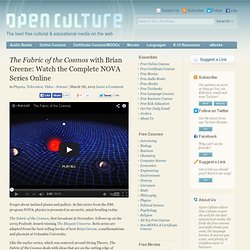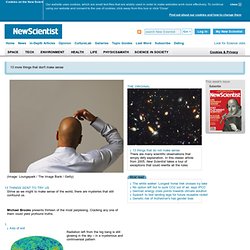

Brian Greene: Welcome to the Multiverse. Brian Greene: Is our universe the only universe? The Fabric of the Cosmos with Brian Greene: Watch the Complete NOVA Series Online. Forget about inclined planes and pulleys.

In this series from the PBS program NOVA, physics is presented as an exotic, mind-bending realm. The Fabric of the Cosmos, first broadcast in November, follows up on the 2003 Peabody Award-winning The Elegant Universe. Both series are adapted from the best-selling books of host Brian Greene, a mathematician and physicist at Columbia University. Like the earlier series, which was centered around String Theory, The Fabric of the Cosmos deals with ideas that are on the cutting edge of scientific theory.
“This is a report from the frontier of cosmic thought,” wrote Dennis Overbye last November in The New York Times, “as fresh as last month’s Nobel Prizes, uncompromising in its intellectual ambitions and discerning in its choice of compelling scientific issues. The series is arranged in four parts of approximately 50 minutes each. Sean Carroll: Distant time and the hint of a multiverse. Ten dimensions. Dark matter mysteries: a true game of shadows - 09 January 2012. Read full article Continue reading page |1|2|3 Far from shedding light on dark matter, our first experimental glimpses of the elusive stuff have only deepened its mystique Editorial: "No more eureka moments" IT'S a troubling time to be looking for the universe's missing matter.

On the face of it, it shouldn't be. Yet any hopes that the nature of the stuff would be quickly revealed by these first detections have been utterly dashed. "The present situation is pretty confusing," admits Juan Collar of the University of Chicago, who is head of the CoGeNT dark matter experiment, based in the Soudan Underground Laboratory in Minnesota. We need dark matter. What's more, dark matter is the missing link in our attempts to move beyond the standard model of particle physics. With both astronomy and particle physics needing more particles to be identified to make sense of observations, theorists began calculating what these entities might be. We might have been fooled, though. More From New Scientist. Brian Greene on string theory.
The Known Universe by AMNH. The Greatest Jupiter Portrait (NASA Cassini Jupiter Images) Kepler-22b a 'Super-Earth' that could hold life: NASA. New planet 'like' Earth NASA has confirmed another planet with characteristics like Earth, and potentially habitable. 6, 2011 In another step towards finding Earth-like planets that may hold life, NASA said on Monday that the Kepler space telescope had confirmed its first-ever planet in a habitable zone outside our solar system.

French astronomers this year confirmed the first rocky exoplanet to meet key requirements for sustaining life. But Kepler-22b, initially glimpsed in 2009, is the first the US space agency has been able to confirm. Super- Earth ... Confirmation means that astronomers have seen it crossing in front of its star three times. Advertisement Such planets have the right distance from their star to support water, plus a suitable temperature and atmosphere to support life as we know it.
"We have now got good planet confirmation with Kepler-22b," said Bill Borucki, Kepler principal investigator at NASA Ames Research Centre. "So we are just thrilled about this. 13 more things that don't make sense. Cookies on the New Scientist website close Our website uses cookies, which are small text files that are widely used in order to make websites work more effectively.

To continue using our website and consent to the use of cookies, click away from this box or click 'Close' Find out about our cookies and how to change them Log in Your login is case sensitive I have forgotten my password close My New Scientist Look for Science Jobs 13 more things that don't make sense (Image: Loungepark / The Image Bank / Getty) Strive as we might to make sense of the world, there are mysteries that still confound us. 10 Images That Changed the Course of Science (And One That Is About To) To understand this you need to understand quantum theory a little better. It's not that orbitals invalidated the stick-and-ball models of chemistry at all. If anything orbitals explained to us why the bonds are arranged as they are in stick-and-ball models. Prior to quantum theory, we only knew the geometry and patterns of those bonds by experiment. Prior to quantum theory, chemistry had no general theory to explain why atomic bonds are shaped as experiment revealed them to be.
We didn't really know the reasons why bonds behaved as we found them to behave.